With its mesmerizing sky-blue hues and powerful metaphysical properties, blue barite is more than just a mineral—it’s a gateway to spiritual awakening. But what gives it its unique color, and where can you find the finest specimens?
Table of Contents
What is Blue Barite?
Blue Barite is a distinctive variety of the mineral barite (barium sulfate), known for its striking blue coloration. Barite itself is a common mineral found worldwide, but the blue variety is considerably rarer and highly sought after by collectors. The captivating blue color can range from pale sky blue to deep azure, making each specimen unique.
Blue Barite crystals typically form as tabular or prismatic structures, often occurring in clusters or rosettes. The blue coloration is believed to result from trace elements or structural defects within the crystal lattice. This mineral is not only valued for its aesthetic appeal but also has several industrial applications due to its unique physical properties.
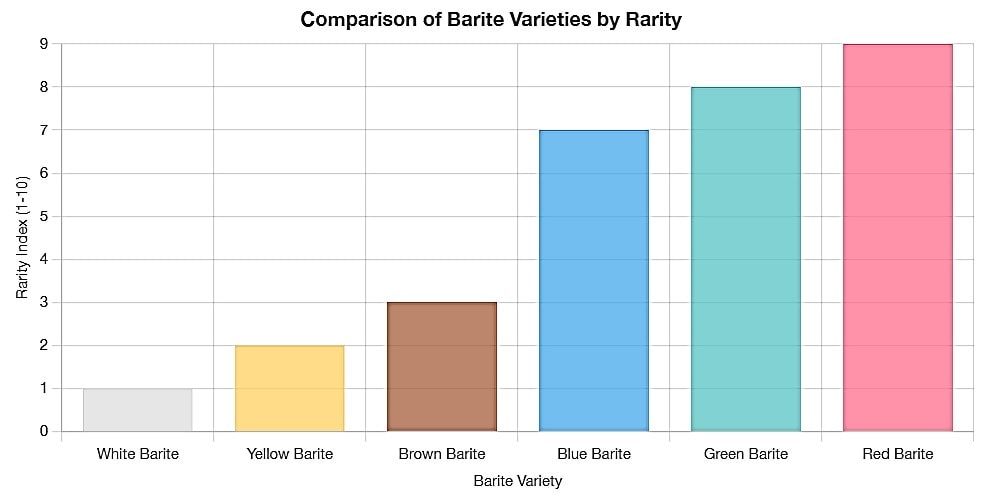
Chemical Composition and Formation of Barite
Barite has the chemical formula BaSO₄ (barium sulfate) and belongs to the barite group of minerals. It typically forms in hydrothermal veins, as a gangue mineral in ore deposits, in sedimentary environments, or as a secondary mineral in limestone.
| Property | Description |
| Chemical Formula | BaSO₄ (Barium Sulfate) |
| Crystal System | Orthorhombic |
| Hardness (Mohs scale) | 3 – 3.5 |
| Specific Gravity | 4.3 – 5.0 (Exceptionally high for a non-metallic mineral) |
| Luster | Vitreous to Pearly |
| Transparency | Transparent to Translucent |
| Color (General) | Colorless, White, Yellow, Brown, Gray |
| Color (Blue Variety) | Pale Blue to Deep Azure |
Blue Barite formation typically occurs through several geological processes:
Hydrothermal Deposition
The most common formation method where barium-rich fluids interact with sulfate-rich solutions in hot springs or deep-sea vents.
Sedimentary Processes
Precipitation from barium-rich waters in sedimentary environments, often associated with marine settings.
Secondary Mineralization
Replacement or alteration of existing minerals in limestone or other carbonate rocks.
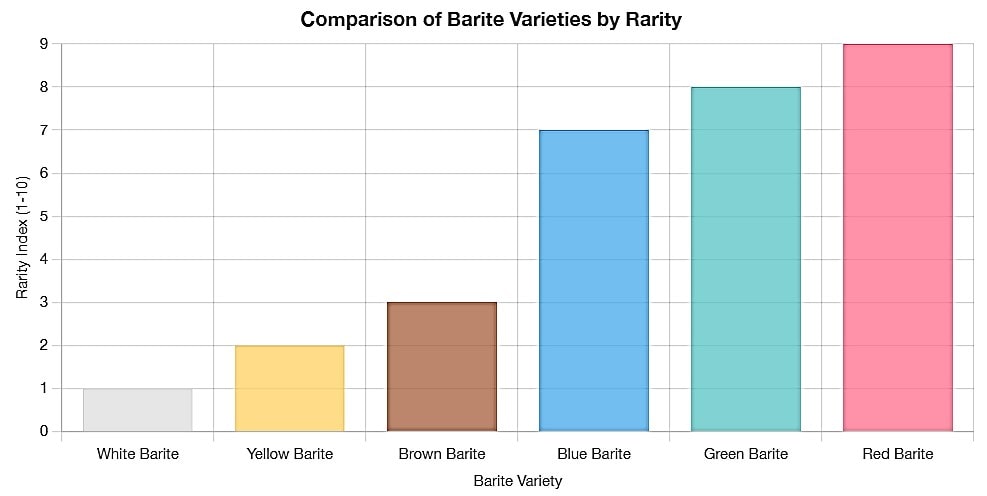
The blue coloration specifically in Blue Barite is still a subject of scientific investigation. Some research suggests it may be due to trace amounts of copper, while other studies propose structural defects in the crystal lattice or the influence of natural radiation over time.
The Unique Properties That Make Blue Barite Special
Blue Barite possesses several distinctive properties that set it apart from other minerals and even from other barite varieties:
| Unique Property | Description | Significance |
| High Specific Gravity | 4.3 – 5.0, uncommonly high for non-metallic minerals | Used in drilling muds, medical imaging, and as a weighting agent |
| Phosphorescence | Some blue barite specimens glow after exposure to ultraviolet light | Valued by collectors and for display purposes |
| Low Solubility | Nearly insoluble in water and common acids | Environmental stability and use in chemical processes |
| Distinctive Blue Color | Ranges from pale sky blue to deep azure | Highly sought after by mineral collectors |
| Characteristic Crystal Forms | Tabular, prismatic, or rosette-like clusters | Important for mineral identification and aesthetic value |
Blue Barite’s combination of properties makes it not only a prized specimen for collectors but also valuable for various industrial applications:

Notable localities for high-quality Blue Barite specimens include:
- Stoneham, Colorado, USA
- Rosiclare, Illinois, USA
- Minas Gerais, Brazil
- Cumberland, England
- Frizington, Cumbria, England
- Sardinia, Italy
- Joplin, Missouri, USA
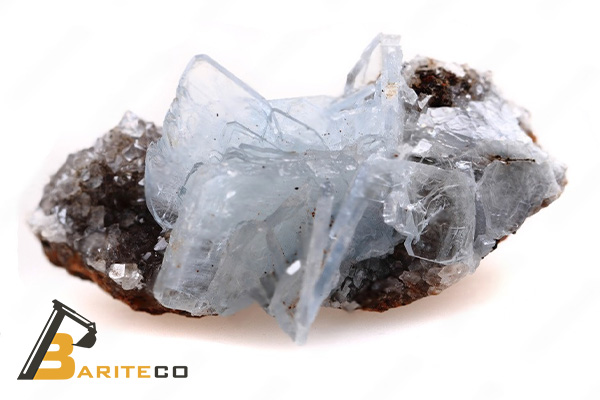
The Geological Journey of Blue Barite
Blue Barite begins its journey deep within the Earth’s crust where barium-rich fluids interact with sulfate ions. This mineral formation process typically occurs over millions of years through various geological processes including hydrothermal activity, evaporation of mineral-rich waters, and precipitation within sedimentary rocks.
The distinctive blue coloration, which makes this variety of Barite particularly prized, develops due to trace elements such as copper or the presence of certain inclusions that absorb and reflect specific wavelengths of light.
Blue Barite typically forms over millions of years through slow crystallization processes. The crystals can range from microscopic to massive formations weighing hundreds of pounds, depending on the conditions during formation.
Geological Timeline of Blue Barite Formation
| Geological Period | Time (Million Years Ago) | Major Formation Events | Resulting Barite Quality |
| Paleozoic | 542-251 | Early marine deposits, hydrothermal activity | Medium to high, often tabular crystals |
| Mesozoic | 251-66 | Increased volcanic activity, marine regression | High quality, diverse crystal habits |
| Cenozoic | 66-present | Mountain building, hydrothermal vents | Highest quality blue specimens |
Where Blue Barite Forms in Nature
Blue Barite forms in specific geological environments that provide the necessary conditions for barium sulfate crystallization. These formations are relatively rare compared to other minerals, making blue specimens particularly valuable to collectors and researchers alike.
The mineral commonly develops in these geological settings:
- Hydrothermal Veins: Where hot, mineral-rich waters circulate through cracks in the Earth’s crust
- Sedimentary Deposits: Especially in marine environments where barium-rich waters mix with sulfate-rich seawater
- Oxidation Zones: Near the surface where existing minerals are altered by oxygen-rich water
- Metamorphic Regions: Where heat and pressure transform existing mineral deposits
Primary Formation Environments of Blue Barite
| Formation Environment | Geological Characteristics | Crystal Habit | Associated Minerals |
| Hydrothermal Veins | Fractures filled with mineral deposits from hot water solutions | Tabular, prismatic | Fluorite, Quartz, Galena |
| Marine Sedimentary Basins | Layered sedimentary rocks formed in ancient seas | Nodular, concretionary | Calcite, Gypsum, Celestine |
| Oxidation Zones | Near-surface weathering environments | Bladed, thin tabular | Limonite, Malachite, Azurite |
| Metamorphic Contacts | Boundary zones between different rock types | Massive, granular | Dolomite, Pyrite, Sphalerite |
Famous Blue Barite Mining Locations Around the World
Blue Barite specimens are highly sought after by collectors and researchers for their aesthetic beauty and scientific value. Several regions around the world are known for producing exceptional blue Barite crystals, each with unique characteristics reflecting their specific formation conditions.
Morocco’s Blue Barite Wonders
Morocco has gained worldwide recognition for producing some of the most stunning blue Barite specimens. The Mibladen and Sidi Lahcen mining districts in particular have yielded extraordinary crystals that showcase the mineral’s captivating azure hues.
Moroccan Blue Barite Characteristics
Moroccan specimens are renowned for their deep blue color, exceptional clarity, and perfect tabular crystal formations. Many crystals exhibit a sandwiched appearance with a blue center surrounded by clear or white Barite layers, creating a distinctive aesthetic prized by collectors.
Famous Moroccan Blue Barite Mining Sites
| Mining Location | Region | Discovery Period | Notable Characteristics |
| Mibladen Mining District | Midelt Province | 1920s, major finds in 1970s-present | Deep blue tabular crystals, often on matrix |
| Sidi Lahcen | Nador Province | 1960s-present | Azure blue prismatic crystals with exceptional luster |
| Aouli | Midelt Province | 1950s-present | Blue-white zoned crystals, often associated with fluorite |
| Oumjrane | Tafilalet Region | 1980s-present | Sky blue small crystals with copper minerals |
American Blue Barite Treasures
The United States has several significant localities for blue Barite, with important deposits found primarily in Colorado, Nevada, and Oklahoma. American specimens are valued for their unique growth patterns and associations with other minerals.
American Blue Barite Distinctions
American blue Barite often forms in clusters of smaller crystals rather than the large tabular specimens found in Morocco. The color tends toward lighter blue to blue-gray hues, and specimens frequently display interesting phantoms or zoning patterns that reveal their growth history.
Notable American Blue Barite Localities
| Mining Location | State | Active Mining Period | Distinctive Features |
| Stoneham | Colorado | 1940s-present | Sky blue to deep blue tabular crystals |
| Red Cloud Mine | Arizona | 1880s-1990s | Blue-tinted tabular crystals with wulfenite |
| Meikle Mine | Nevada | 1980s-2000s | Light blue crystals with gold inclusions |
| Elk Creek | South Dakota | 1970s-present | Blue-gray zoned crystals |

The Distinctive Physical Properties of Blue Barite
Blue Barite stands out among minerals for its distinctive physical properties that make it both scientifically fascinating and aesthetically appealing. Understanding these properties helps to appreciate why this mineral is highly valued by collectors and researchers alike.
Color Variations and Causes of Blue Hues
Blue barite displays a fascinating spectrum of blue coloration ranging from pale sky blue to deep sapphire tones. The distinctive blue color primarily results from trace impurities and structural factors rather than barite’s inherent chemical composition. The most significant color-causing mechanism is the presence of trace elements that substitute for barium in the crystal lattice.
Copper ions (Cu2+) often contribute to azure and turquoise tones in barite, while trace amounts of cobalt can produce deeper blue hues. Additionally, color centers defects in the crystal structure where electrons become trapped can absorb certain wavelengths of light, enhancing the blue appearance. The vibrancy and specific shade of blue in barite specimens directly correlates with both the type and concentration of these color-causing agents.
Environmental factors during formation, such as temperature, pressure, and the chemical composition of surrounding fluids, significantly influence the resulting color profile. This explains why blue barite specimens from different global locations often display regionally distinctive blue characteristics.
Crystal Structure and Formation Patterns
Blue barite crystallizes in the orthorhombic system, forming tabular or prismatic crystals with perfect cleavage in three directions. This distinctive crystalline architecture contributes to barite’s characteristic shape and optical properties. Unlike many minerals that form in cubic or hexagonal systems, barite’s orthorhombic structure creates unique growth patterns that influence how the crystals develop in natural environments.
The formation pattern of blue barite typically follows one of several pathways. Hydrothermal deposition occurs when barium-rich solutions cool and precipitate barite in veins, cavities, or along fault lines. Evaporitic formation happens when barium-rich water bodies evaporate, leaving concentrated deposits behind. Biogenic formation involves marine organisms facilitating barite precipitation in ocean environments. Each formation mechanism creates distinctive crystal habits and clustering patterns.
Blue barite commonly exhibits several notable crystal habits including tabular (flat, plate-like), prismatic (elongated, column-like), and rosette formations (clustered crystals arranged in a circular pattern). The specific growth environment particularly fluid composition, temperature, pressure, and available space determines which habit predominates in a specimen. This structural diversity contributes significantly to blue barite’s aesthetic appeal and collector value.
Hardness, Density, and Other Physical Characteristics
Blue barite possesses a moderate hardness of 3-3.5 on the Mohs scale, making it relatively soft compared to many minerals yet durable enough for careful handling and display. This hardness profile means that while barite can be scratched by many common materials (including steel), it remains resistant to casual damage and maintains its form well when properly preserved. The moderate hardness also contributes to barite’s distinctive luster, which ranges from vitreous (glass-like) to pearly depending on the crystal face examined.
Perhaps the most remarkable physical property of blue barite is its exceptionally high density of 4.3-5.0 g/cm³, which gives specimens a surprising heft when handled. This high specific gravity results from the presence of barium, a heavy element with atomic number 56. The density is so distinctive that “heavy spar” became an early common name for the mineral. This property makes barite valuable for numerous industrial applications, including as a weighting agent in drilling fluids for oil and gas wells.
Additional notable physical characteristics include barite’s low thermal conductivity, making it cool to the touch even in warm environments, and its high refractive index, which contributes to its visual brilliance. Blue barite is also non-magnetic and insoluble in water and most common acids. When heated strongly, barite decrepitates (fragments with crackling sounds) due to the expansion of internal fluid inclusions. These combined properties create a mineral that is not only visually striking but also physically distinctive when examined or handled.
Key Physical Properties of Blue Barite
| Property | Value/Description | Significance |
| Chemical Formula | BaSO₄ | Defines mineral identity |
| Crystal System | Orthorhombic | Determines crystal shape and growth patterns |
| Hardness | 3-3.5 (Mohs) | Determines durability and handling characteristics |
| Density | 4.3-5.0 g/cm³ | Creates distinctive heft; used in industrial applications |
| Luster | Vitreous to pearly | Affects visual appearance and light reflection |
| Cleavage | Perfect in three directions | Influences fracture patterns and crystal appearance |
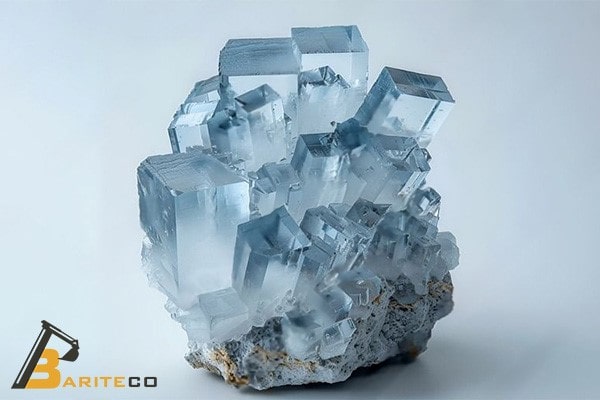
Blue Barite in Historical Context
Blue barite has a rich and fascinating history that spans thousands of years, from ancient civilizations to modern scientific applications. This remarkable mineral has been valued for its unique properties and stunning appearance throughout human history.
Blue barite (BaSO₄) stands out among minerals for its distinctive blue color, high specific gravity (4.5), and its historical significance in various cultures. From ancient Egypt to modern industrial applications, this mineral has played important roles in human civilization.
Ancient Uses and Knowledge of Barite
Archaeological evidence suggests that barite, including its blue variants, was known and utilized by several ancient civilizations. The mineral’s unique properties made it valuable for various applications, from practical tools to ceremonial artifacts.
Ancient Egypt
Egyptian craftsmen used ground barite as a white pigment in tomb paintings and cosmetics. The mineral’s high density made it an excellent base for makeup and artistic works.
Mesopotamian Alchemy
Ancient Mesopotamian alchemists valued barite for its unusual weight and included it in early metallurgical experiments and medicinal preparations.
Roman Construction
Romans incorporated barite into certain specialized building materials, taking advantage of its density for sound insulation in particular structures.
The distinctive blue variety of barite was particularly prized in ancient times. Its color, reminiscent of lapis lazuli but with different physical properties, made it a subject of curiosity and sometimes confusion among early mineralogists and craftsmen.
| Time Period | Civilization | Primary Uses of Barite | Significance |
| 3000-1000 BCE | Ancient Egypt | Pigments, cosmetics, ritual objects | Associated with the god Thoth and wisdom |
| 2000-500 BCE | Mesopotamia | Medicinal compounds, early alchemy | Believed to have healing properties |
| 500 BCE-500 CE | Ancient Rome | Construction, pigments, weighted objects | Valued for its unusual density |
| 200-1500 CE | China | Medicine, ceramic glazes | Mentioned in early Chinese mineralogical texts |
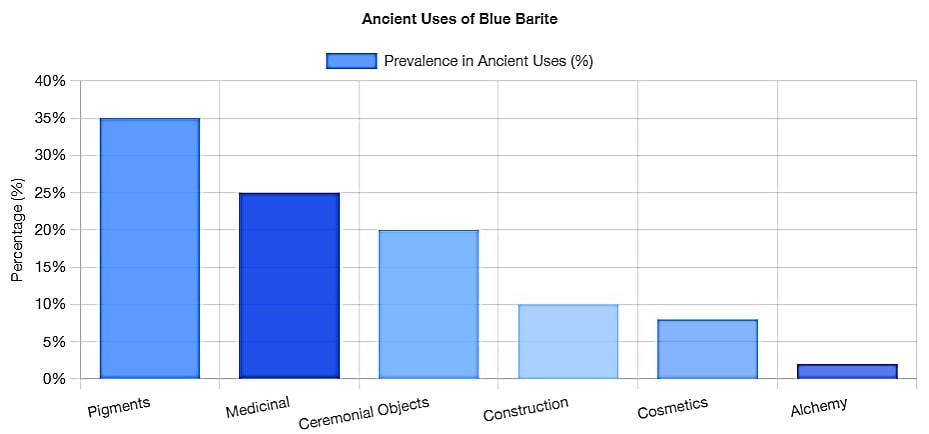
Historical Significance: While not as famous as gemstones like sapphire or lapis lazuli, blue barite held special significance in ancient civilizations due to its unusual weight and color. Archaeological findings suggest it was sometimes used in ritual objects believed to communicate with deities associated with the sky or water.
How Blue Barite Gained Popularity in Modern Times
The journey of blue barite from a mineral curiosity to a highly sought-after collector’s specimen and industrial material is a fascinating story of scientific discovery, industrial innovation, and aesthetic appreciation.
1800s
Scientific classification of barite as a distinct mineral species. European mineralogists document the first comprehensive studies of barite’s properties.
1850-1900
Industrial Revolution drives demand for barite in paper manufacturing, paint production, and as a weighting agent in various applications.
Early 1900s
Discovery of barite’s value in oil drilling mud revolutionizes the petroleum industry and creates unprecedented demand for the mineral.
1950s-1970s
Growth in mineral collecting as a hobby brings attention to aesthetic specimens, including blue barite crystals from specific localities like Morocco.
1980s-2000s
New discoveries of spectacular blue barite specimens in Morocco, China, and the United States create excitement in the collector community.
2000s-Present
Social media and mineral shows spread awareness of blue barite’s beauty. Scientific interest grows in understanding the cause of blue coloration in barite crystals.
The modern popularity of blue barite can be attributed to several converging factors, including increased global communication among collectors, improved mining techniques that preserve crystal specimens, and greater scientific understanding of mineral formation processes.

| Modern Application | Sector | Importance of Blue Barite | Market Growth |
| Mineral Collection | Hobby/Luxury | Highly valued for aesthetic properties | Strong growth (15-20% annually) |
| Radiation Shielding | Medical/Industrial | Used for its density regardless of color | Moderate growth (5-8% annually) |
| Scientific Research | Academic/R&D | Studied for color mechanisms and crystal growth | Steady growth (3-5% annually) |
| Healing Crystals | Alternative Health | Believed by some to have calming properties | Variable growth (10-15% annually) |
Collector’s Perspective: “The appeal of blue barite lies not only in its striking color but in the perfect geometric forms its crystals often take. A well-formed blue barite specimen represents the intersection of artistic beauty and mathematical precision that makes mineral collecting so fascinating.” Dr. Robert Thompson, Mineralogical Society of America
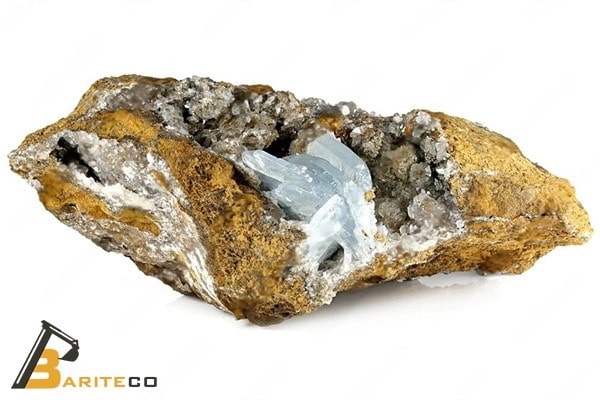
Metaphysical Properties and Healing Attributes
Blue Barite possesses an extraordinary range of metaphysical properties that make it highly valued in crystal healing circles. Its unique vibration offers profound healing benefits for the mind, body, and spirit, creating a harmonious balance within the energetic system. The crystal’s properties work on multiple levels, addressing physical ailments while simultaneously elevating consciousness.
| Property | Description | Benefit |
| Vibration | High frequency | Enhanced spiritual awareness |
| Element | Water and Air | Emotional healing and mental clarity |
| Chakra | Throat and Third Eye | Improved communication and intuition |
| Zodiac | Aquarius, Pisces | Enhanced creativity and spiritual insight |
| Numerical Vibration | 8 | Manifestation and abundance |
Blue Barite’s Energy and Vibrational Qualities
Blue Barite carries a distinctive energetic signature characterized by its high vibrational frequency that resonates primarily with the upper chakras. The crystal emits a calming yet expansive energy that helps to open the mind to higher states of consciousness while maintaining a grounded presence.
The vibrational quality of Blue Barite creates a harmonious field around the user, helping to clear electromagnetic pollution and balance the body’s own electromagnetic field. This protective energy shield makes Blue Barite particularly valuable in our modern environment filled with electronic devices.
| Vibrational Quality | Effect on Energy Field |
| Frequency Range | High, resonating with upper chakras |
| Energy Pattern | Radiating waves with harmonizing effect |
| Protective Qualities | Shields from EMF and negative energies |
| Auric Influence | Expands and brightens the aura |
| Subtle Body Activation | Stimulates the etheric and astral bodies |
Crystal Healing Applications of Blue Barite
In crystal healing practices, Blue Barite is utilized in various therapeutic applications. Its versatile energy makes it suitable for addressing both physical discomforts and emotional imbalances. Practitioners often recommend Blue Barite for its ability to enhance other healing modalities and amplify the effects of complementary crystals.
| Healing Application | Method | Expected Benefit |
| Meditation | Holding or placing on third eye | Enhanced visualization and deeper states |
| Chakra Balancing | Placement on throat and third eye | Improved energy flow and communication |
| Sleep Enhancement | Placed under pillow or by bedside | Peaceful sleep and spiritual dreams |
| Energy Healing | Used in grid formations or layouts | Amplified healing energies and manifestation |
| Emotional Therapy | Carried as a pocket stone | Stress reduction and emotional stability |
Mental Clarity and Communication Benefits
One of Blue Barite’s most valued properties is its ability to enhance mental clarity and improve communication skills. When working with this crystal, many people report experiencing clearer thought processes, improved memory, and a greater ability to articulate their ideas.
The crystal’s connection to the throat chakra helps to dissolve communication blockages, allowing for more authentic self-expression. This makes it particularly beneficial for public speakers, writers, teachers, and anyone who relies on clear communication in their daily life.
| Mental Benefit | Communication Benefit |
| Enhanced problem-solving abilities | Clearer verbal expression |
| Improved focus and concentration | Reduced speech anxiety |
| Better information retention | More authentic self-expression |
| Clearer decision-making | Enhanced listening skills |
| Reduced mental fog | Improved written communication |
Spiritual Connection and Third Eye Activation
Blue Barite is deeply connected to spiritual awakening and third eye activation. The crystal’s unique frequency helps to open and balance the third eye chakra, enhancing intuition, psychic abilities, and spiritual vision. Many practitioners use Blue Barite during meditation to deepen their connection to higher realms of consciousness.
By stimulating the third eye chakra, Blue Barite can help to develop clairvoyance and enhance dream recall. It creates a bridge between the conscious and subconscious mind, facilitating greater spiritual awareness and insights. The crystal is often used in spiritual practices aimed at developing extrasensory perception and expanding consciousness.
| Spiritual Attribute | Third Eye Benefit |
| Enhanced meditation experiences | Clearer intuitive insights |
| Stronger connection to spirit guides | Improved visualization abilities |
| Access to akashic records | Enhanced dream recall and lucid dreaming |
| Higher states of consciousness | Development of clairvoyant abilities |
| Deeper spiritual understanding | Balanced perception of reality |
Collecting and Displaying Blue Barite
Building a collection of Blue Barite specimens can be a rewarding endeavor for crystal enthusiasts and mineral collectors alike. These striking blue crystals make impressive display pieces and valuable additions to any mineral collection. Understanding how to identify quality specimens and properly care for your collection will ensure your Blue Barite maintains its beauty and energetic properties for years to come.
| Collection Aspect | Recommendation |
| Display Method | Glass cabinets with LED lighting, individual acrylic stands |
| Ideal Environment | Low humidity, stable temperature, away from direct sunlight |
| Organization | By size, color intensity, or formation type |
| Complementary Crystals | Celestite, Blue Lace Agate, Clear Quartz |
| Documentation | Origin labels, acquisition details, energetic properties |
Tips for Identifying Quality Specimens
Finding high-quality Blue Barite specimens requires knowledge of what to look for and how to distinguish authentic crystals from treated or synthetic alternatives. The market value and metaphysical potency of Blue Barite are directly related to several key quality factors that experienced collectors evaluate when adding to their collection.
When searching for premium Blue Barite specimens, pay special attention to color saturation, crystal formation, and overall condition. Natural specimens with minimal damage and vibrant coloration command higher prices and are considered more effective for metaphysical work.
| Quality Factor | What to Look For | Red Flags |
| Color | Rich, even blue coloration; natural variations | Unnaturally bright or inconsistent color; dyed appearance |
| Crystal Structure | Well-formed tabular or prismatic crystals | Poorly defined crystal faces; excessive fragmentation |
| Transparency | Clear to translucent quality depending on specimen | Cloudiness not natural to the specimen; artifical clarity |
| Matrix | Natural host rock that enhances the specimen’s appearance | Artificially attached crystals; reconstructed specimens |
| Provenance | Documented origin from known Blue Barite locations | Vague origins; misrepresented locale information |
Expert Tip: When purchasing Blue Barite, examine the crystal under different lighting conditions. Natural Blue Barite will show subtle variations in color and may display pleochroism (different colors when viewed from different angles), which is difficult to replicate in synthetic or treated specimens.
Practical Uses of Blue Barite Beyond Collection
While Blue Barite is highly prized by collectors and crystal enthusiasts for its metaphysical properties, this mineral also serves numerous practical purposes beyond display cases and healing sessions. From crucial industrial applications to creative artistic uses, Blue Barite’s unique properties make it valuable across multiple sectors and disciplines.
Understanding the practical applications of Blue Barite provides collectors with a deeper appreciation for this versatile mineral and highlights its importance to society beyond its aesthetic and spiritual appeal. The diverse uses of Barite demonstrate how a single mineral can bridge the gap between scientific utility and artistic expression.
| Category | Applications | Value Proposition |
| Industrial | Drilling fluid additive, radiation shielding, paint manufacturing | High specific gravity, chemical stability, radiation absorption |
| Art & Decor | Sculptures, jewelry, interior design elements | Aesthetic appeal, unique crystal formation, color variety |
| Scientific | Research specimen, educational models, calibration standard | Consistent properties, well-understood composition, accessibility |
| Agriculture | Soil amendment, trace mineral supplement | Barium content, mineral release profile, soil conditioning |
| Environmental | Water purification, contamination indicators | Ionic exchange capacity, sensitivity to environmental changes |
Industrial Applications of Barite
The industrial sector represents the largest consumer of Barite minerals, including blue varieties. The exceptional density and chemical inertness of Barite make it invaluable for numerous applications across multiple industries, from energy production to medical imaging. While the more common white and clear Barite varieties are typically used in industrial settings, high-quality Blue Barite may be utilized for specialized applications.
The demand for Barite in industrial applications continues to grow, driven by expanding energy exploration and the development of new technologies that leverage the mineral’s unique properties. Understanding these industrial uses provides context for the economic importance of Barite deposits worldwide.
| Industry | Application | Function of Barite |
| Oil & Gas | Drilling mud additive | Increases fluid density to control well pressure and prevent blowouts |
| Medical | Barium contrast medium | Provides opacity for X-ray and CT imaging of digestive tract |
| Radiation Protection | Shielding material | Absorbs radiation in medical facilities, nuclear plants, and laboratories |
| Paint Manufacturing | Pigment and filler | Provides weight, opacity, and corrosion resistance in industrial coatings |
| Automotive | Brake linings and clutches | Adds weight and thermal stability to friction materials |
Industrial Insight: The petroleum industry alone consumes approximately 80% of global Barite production, primarily for drilling operations. Quality standards for industrial Barite are strictly regulated, with specific gravity requirements typically set at 4.2 or higher for drilling applications a density substantially greater than most common minerals.
Blue Barite in Art and Decoration
The striking blue color and distinctive crystal formations of Blue Barite make it a coveted material for artists, designers, and decorators. Unlike its industrial applications, where the mineral is typically processed and its natural form altered, artistic and decorative uses of Blue Barite celebrate and showcase the mineral’s natural beauty and unique crystalline structure.
From statement jewelry pieces to sophisticated home décor elements, Blue Barite adds a touch of natural elegance and spiritual significance to artistic creations. The versatility of this mineral allows for diverse applications across multiple creative disciplines.
| Creative Field | Applications | Design Considerations |
| Jewelry Design | Pendants, statement rings, artistic brooches | Requires protective settings due to softness; best used for occasional wear pieces |
| Sculpture | Mineral art, mixed-media installations, crystal gardens | Often combined with more durable materials; requires stable mounting |
| Interior Design | Focal display pieces, bookends, table centerpieces | Positioned away from high-traffic areas; protected from humidity |
| Fashion | Couture embellishments, runway pieces, accessory accents | Used symbolically; smaller specimens incorporated into durable settings |
| Photography | Artistic compositions, product styling, editorial features | Valued for color contrast and light interaction; often paired with other minerals |
Designer’s Note: When incorporating Blue Barite into decorative objects or art pieces, lighting plays a crucial role in highlighting the crystal’s natural beauty. LED lighting with adjustable color temperature can enhance the blue coloration, while strategic positioning can create captivating shadow patterns from the tabular crystal formations.
Conclusion
Blue Barite represents a remarkable convergence of scientific wonder and natural beauty. Its journey from deep within the Earth’s crust to collectors’ displays worldwide tells a compelling story of geological processes that create something truly extraordinary. The crystal’s striking azure formations not only captivate with their aesthetic appeal but serve diverse purposes across industrial applications, metaphysical practices, and artistic expressions.
What truly sets Blue Barite apart is its unique combination of properties the heaviness that betrays its barium content, the perfect geometric formations that reflect nature’s mathematical precision, and the calming blue hues that resonate with our inner sense of tranquility. Whether appreciated for its scientific significance, metaphysical attributes, or simply its natural beauty, Blue Barite continues to bridge the worlds of practicality and wonder, offering something meaningful to everyone who encounters it.
FAQ
1. Is blue barite rare compared to other barite colors?
Yes, blue barite is considerably rarer than white, clear, or yellow varieties of barite. The blue coloration requires specific trace elements or radiation effects during formation, making it less common in nature. While barite itself is relatively abundant (it’s the most common barium mineral), the blue variety represents a small percentage of total barite deposits. This relative scarcity contributes to its value among collectors, though it’s not as rare as some other mineral varieties.
2. How can I tell the difference between blue barite and other similar blue minerals?
Blue barite can sometimes be confused with blue celestite (strontium sulfate), blue topaz, or certain varieties of blue fluorite. The most reliable distinguishing characteristics include:
Weight: Barite is noticeably heavier than similar-looking minerals
Crystal structure: Barite’s distinctive tabular or bladed orthorhombic crystals
Hardness: At 3-3.5 on the Mohs scale, barite is softer than many look-alikes
Streak test: Barite always produces a white streak when rubbed on unglazed porcelain
When in doubt, a professional mineralogist can perform more definitive tests, including specific gravity measurements or spectroscopic analysis.
3. Will my blue barite fade over time?
Some specimens of blue barite may gradually fade if exposed to strong direct sunlight or UV light for extended periods. The photosensitivity varies between specimens, depending on exactly what causes the blue color. To preserve the vibrant blue color of your specimens, keep them away from direct sunlight and consider display cases with UV-filtering glass. With proper care, many blue barite specimens maintain their color for decades.
4. Can blue barite be used in water for crystal elixirs?
This is not recommended. While barite has low solubility in water, it contains barium, which can be toxic if ingested in sufficient quantities. Although the risk from brief water contact is minimal, it’s better to use the indirect method for any crystal elixirs placing the stone outside a sealed glass container of water rather than in direct contact with the water. This provides the supposed energetic properties without any risk of contamination.
5. What is the most valuable type of blue barite specimen?
The most valuable blue barite specimens typically come from Morocco and feature large, well-formed crystals or rosettes with deep, even blue coloration and good transparency. Specimens that include aesthetic combinations with other minerals (such as barite on a constrasting matrix) can command premium prices. Large cabinet specimens (4-5 inches or larger) with perfect crystal formation and intense blue color from famous localities can sell for hundreds or even thousands of dollars to serious collectors. However, beautiful smaller specimens are available at much more accessible price points, making blue barite collectible at various budget levels.
Have you experienced the calming energy of blue barite? Share your story in the comments—or ask us how to spot the highest vibrational specimens!
